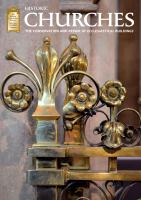

BCD SPECIAL REPORT ON
HISTORIC CHURCHES
22
ND ANNUAL EDITION
19
Specialist decoration, restoration and conservation
to the highest standard since 1873
Marbling, graining, stenciling, gilding and special decorative
effects carried out by fully trained experienced craftsmen.
Principal contractors for restoration and conservation projects.
99 Fleet Road, Fleet, Hampshire GU51 3PJ
Tel 01252 618002
ByAppointment to
HerMajesty theQueen
Decorators andGilders
CloughHarris Ltd.
CLOUGH HARRIS LIMITED
DECOR ATORS, GILDERS & RESTORERS
Mumford House, Church Hill, Kingsnorth, Ashford, Kent TN23 3EG
Tel: 01233645555 Fax: 01233645556
E-mail:
clough-harris@btconnect.com www.cloughharris.co.ukCONSERVATORS & RESTORERS
at about the same time that angel corbels started to be so
widely used. It might be expected that the Prior at Ely would
not presume to decorate the corbels of his Great Hall with
angels. Those now visible in what has become the Bishop’s
House are first class sculptures of secular characters (page 16)
and stylistically close to work seen in the cathedral octagon
(completed 1340). Traces of colour grin through recent paint
layers, reminding us that all these stone and wooden carvings
were once highly coloured.
The church of Sutton-in-the-Isle just west of Ely and
probably rebuilt by Bishops Barnet and Arundel (1366–88) has
similar carved figure corbels (though harshly restored), giving
the same impression of carrying the wall post on their backs.
They derive from classical ‘Atlas’ figures and were used in the
Romanesque period, for example supporting the ribs of the
chapter house at Durham.
Elsewhere in Cambridgeshire around 1400 such Atlas
figures can be quite comical. At Barrington and Whaddon, the
same mason seems to be following the Ely and Sutton style,
but his faces can be quite grotesque and snarling lions (page 18,
centre right) and winged demons now appear in the set. They
also seem to be shouting at the congregation below (above).
Are they warning or denouncing? At Harlton and Harston a
little later, the mood lightens with distinctly secular figures,
some of them musicians, others gurning (page 17, top left). The
faces seem standardised, but here and there is the suggestion
of a portrait, perhaps caricaturing the mason’s workmate!
Portraits can be more confidently identified as such when
a man and woman face each other or face down into the
congregation from the corbels adjacent to the tower (as at
Sutton) or rood loft, suggesting they are the patrons. A very
fine set of medieval busts can be seen at St Peter Mancroft
in Norwich (page 18, bottom left). Although sited on top of a
castellated stone capital, they are actually of wood like the wall
post above.
As elsewhere, such fine carvings have had lights and
speakers placed up against them and the inevitable cabling
can run around them like a noose (page 18, bottom right).
Thick layers of limewash obscure details although they
can protect the corbel, especially when roof staining
or chemical treatments are allowed to run down.
Not all stone corbels are carved to the highest standards and
we have yet to fully understand what messages their sculpture
was intended to convey. Full of character and interest, however,
they are valuable survivals of medieval art and deserve both
better care and wider appreciation.
RICHARD HALSEY
FSA, now retired, was English Heritage’s faith
buildings manager. He is president of the British Archaeological
Association (thebaa.org) and maintains an active research interest in
medieval architecture. Email
richard@rhalsey.co.ukGrotesque secular busts at All Saints, Barrington, Cambridgeshire
















